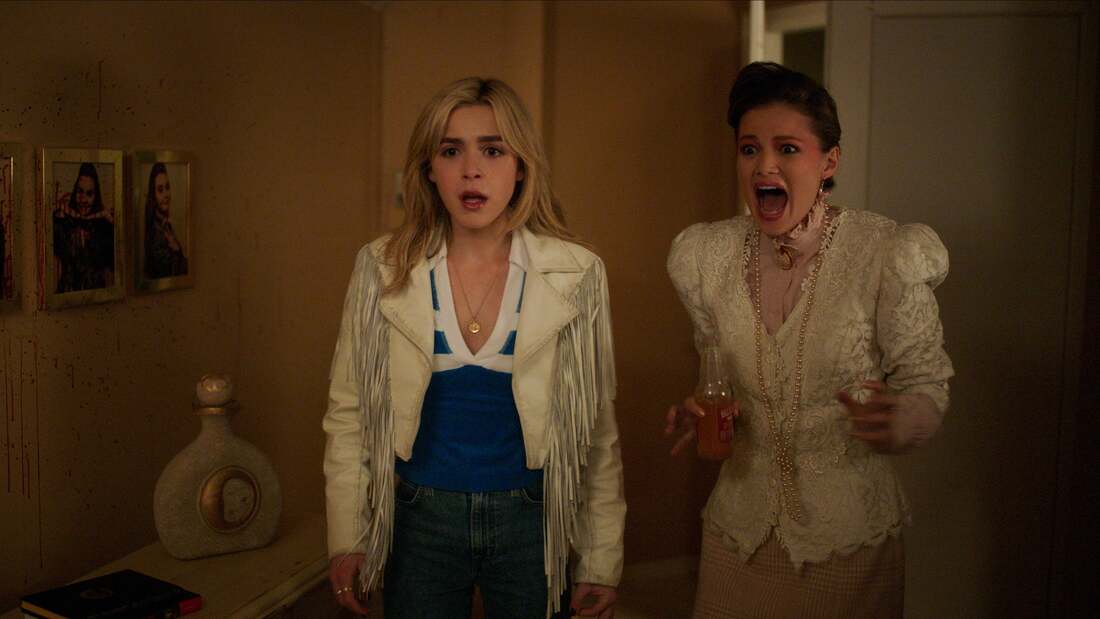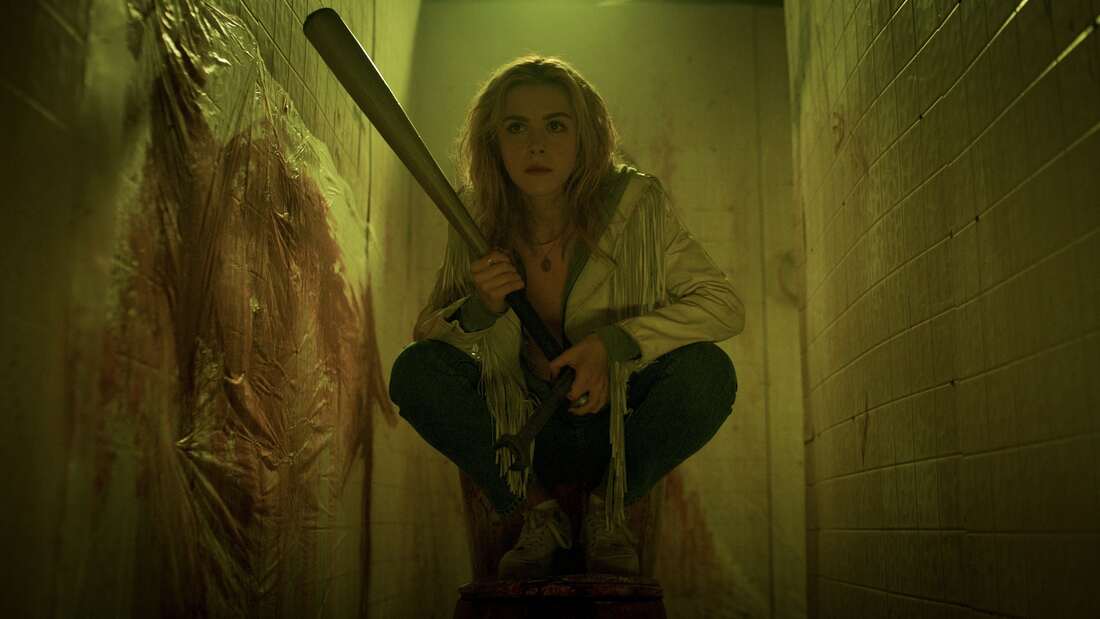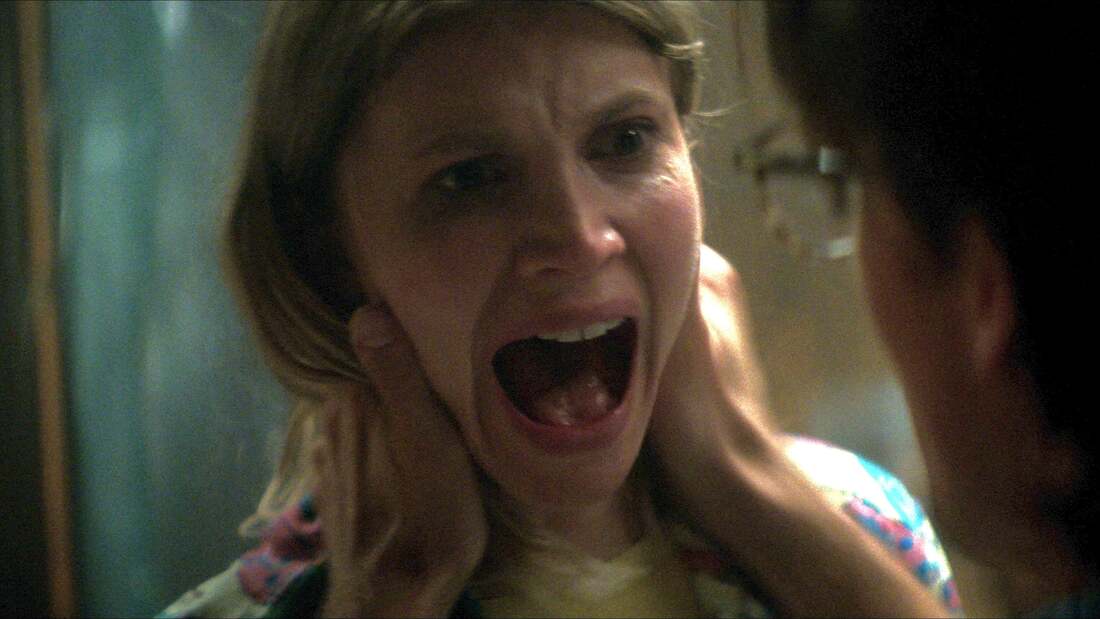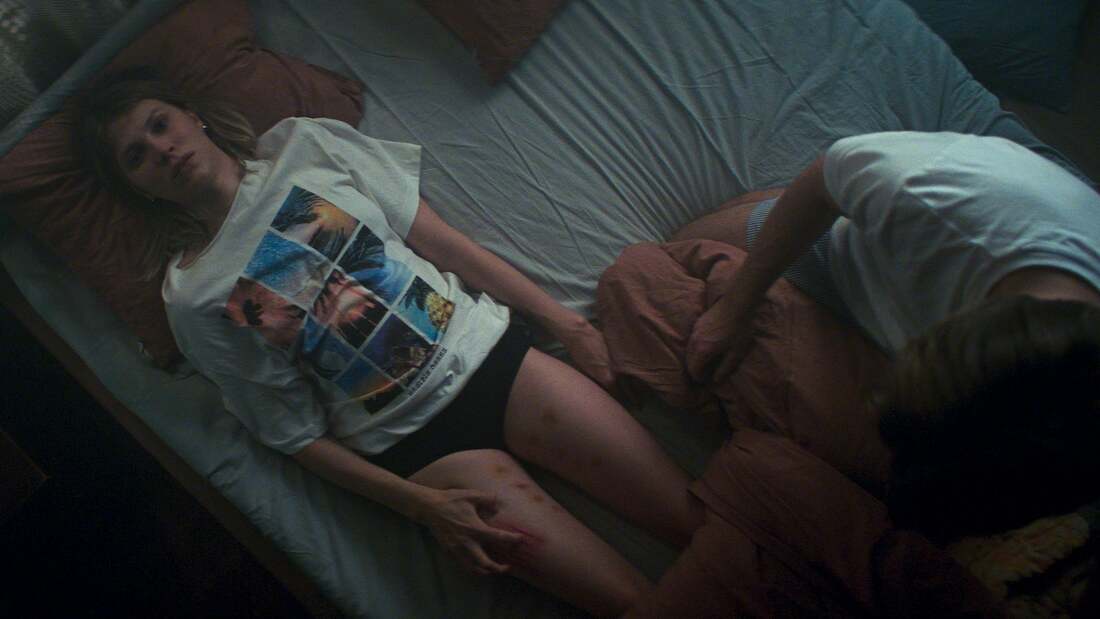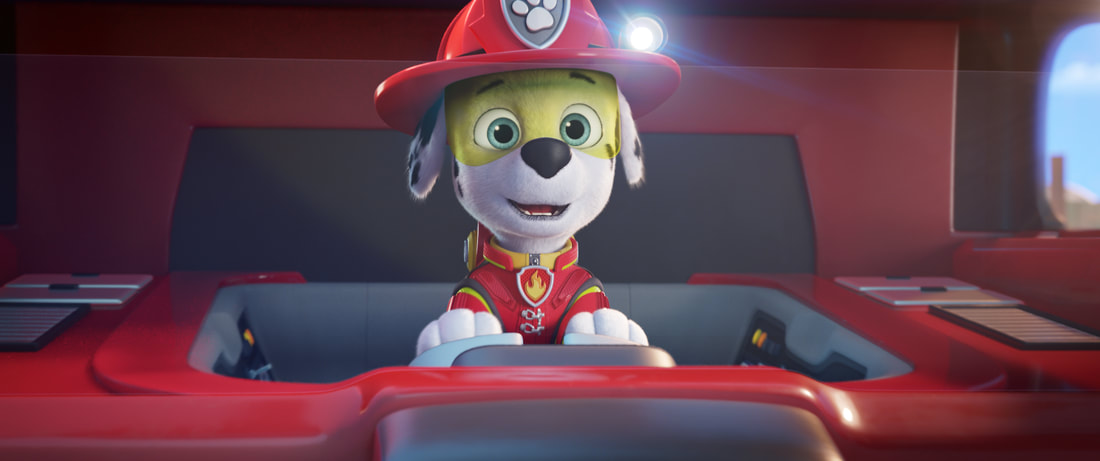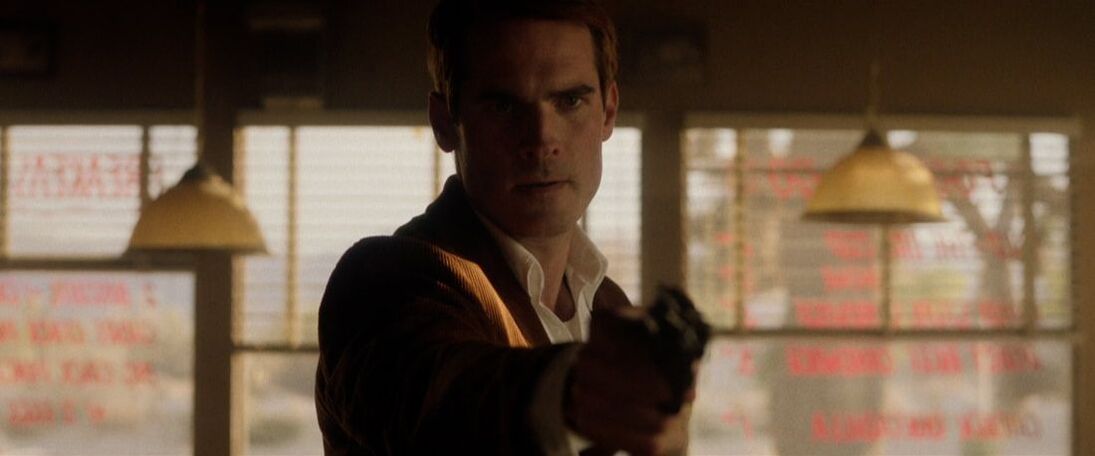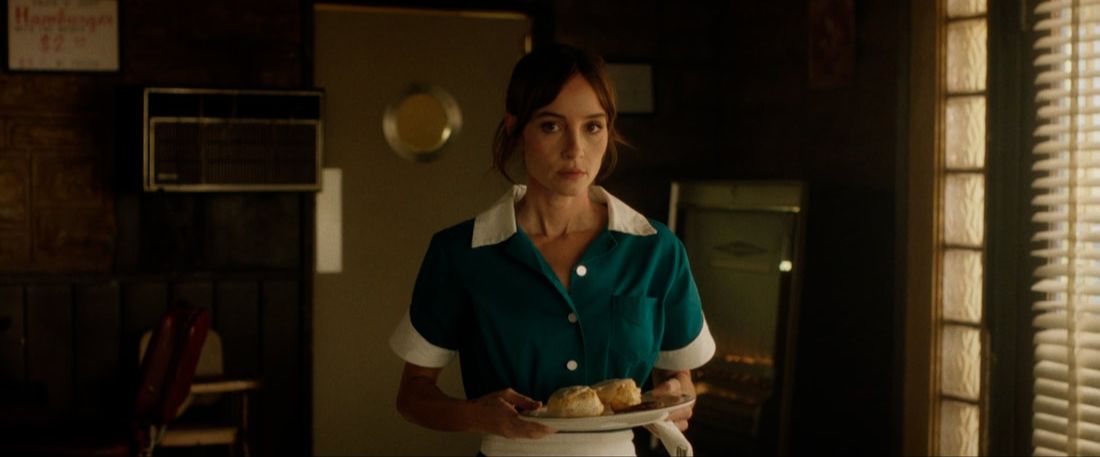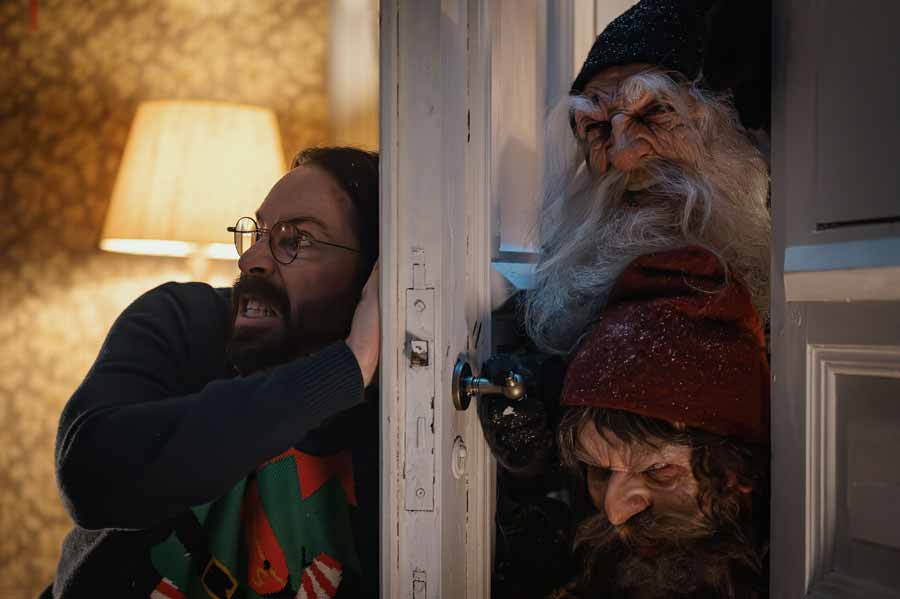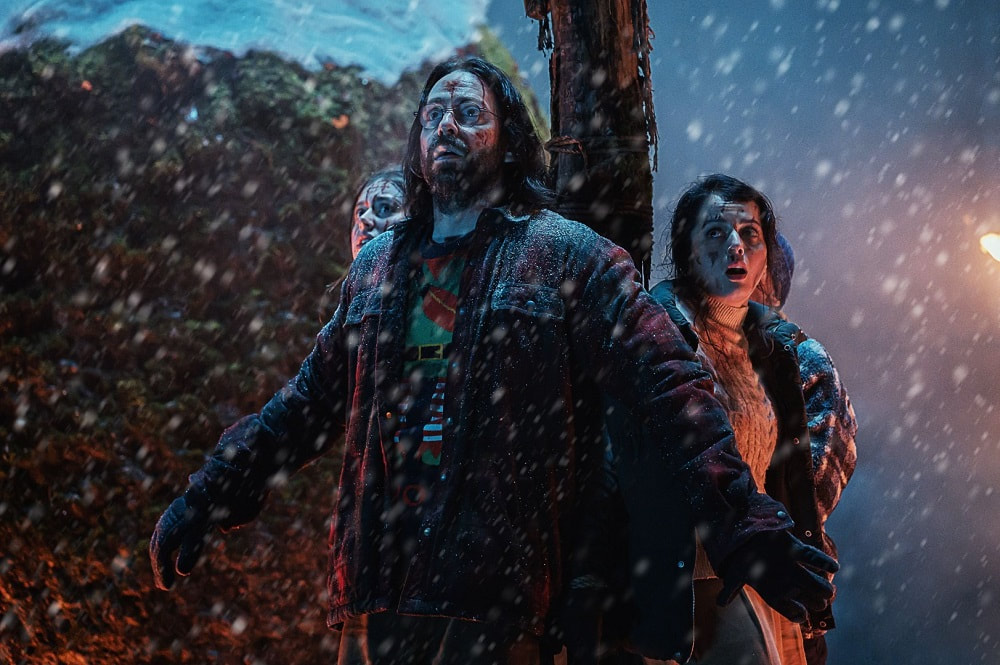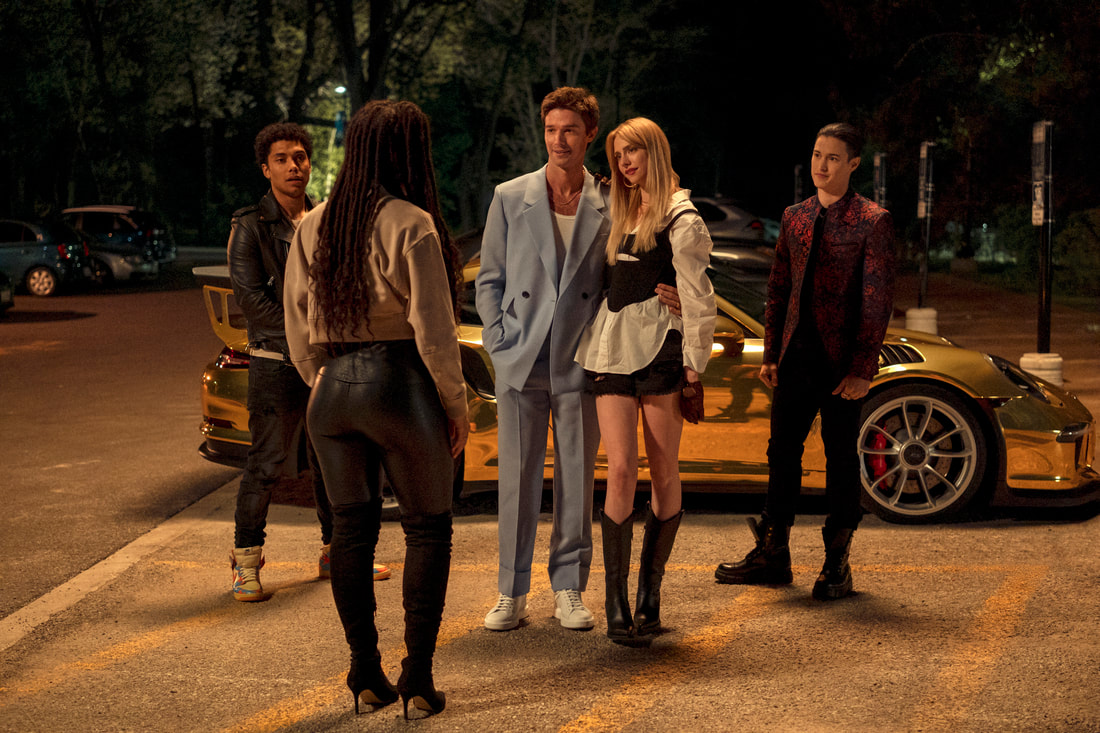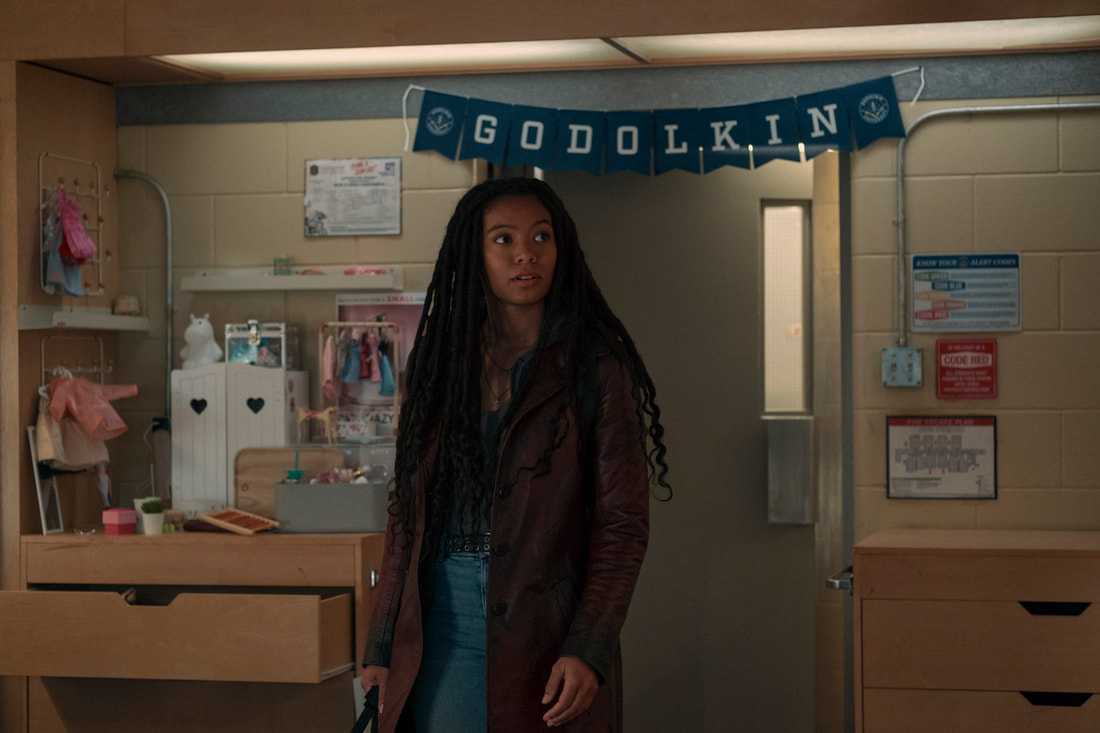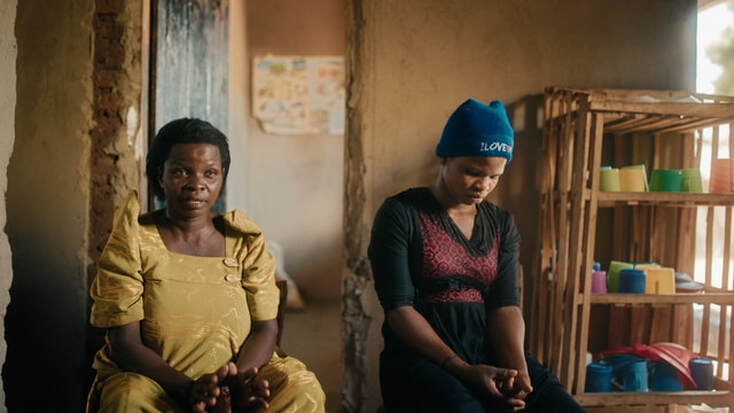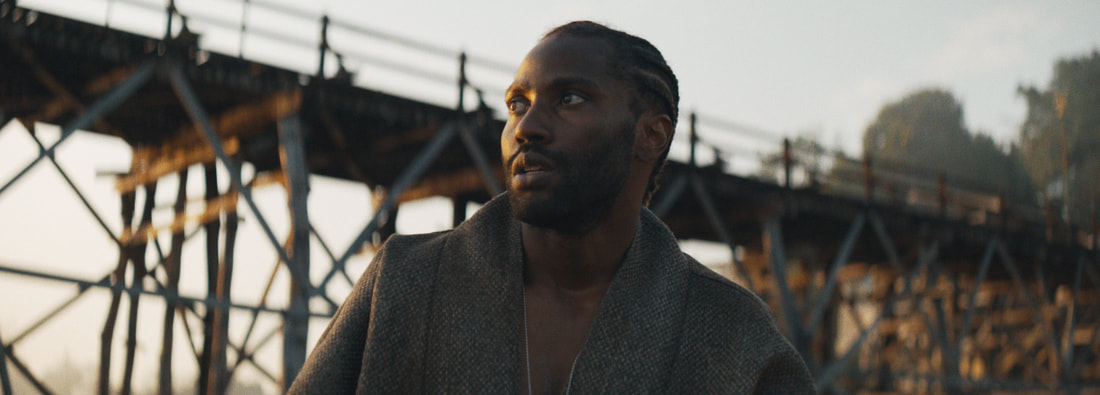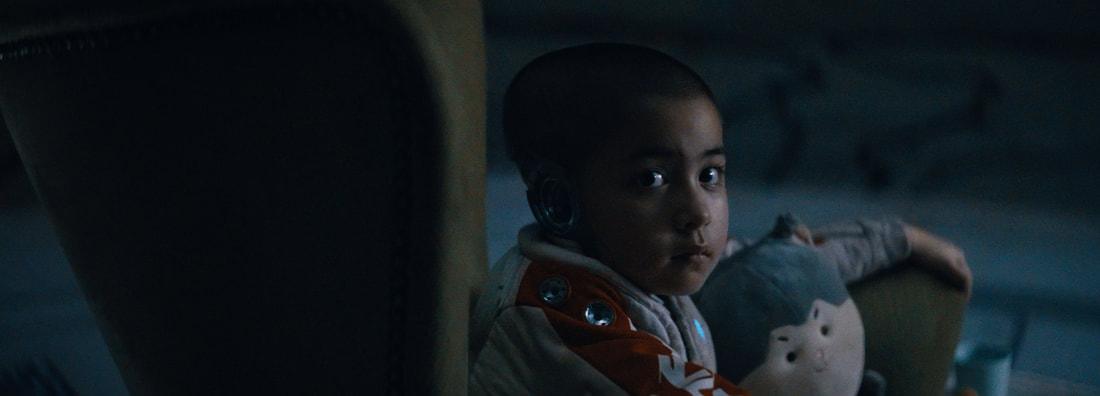[Fantastic Fest 2023] TOTALLY KILLER -- Kiernan Shipka Kills it in Time-Twisty Horror-Comedy9/29/2023 Review by Cole Groth There’s nothing quite as cool as a good time travel movie. Taking an already interesting genre — whether it be a rom-com, sci-fi, or horror film — and throwing in time travel is a great way to make something distinctive and unique. Totally Killer is a time-traveling blast that combines excellent slasher elements with solid humor to make something consistently interesting. Nahnatchka Khan’s sophomore feature follows Jamie (Kiernan Shipka), your typical angsty teenage girl, who travels back to the past after a notorious serial killer makes his return by murdering her mother (Julie Bowen). While in the past, Jamie has to work with the also-angsty teenage version of her mother (Olivia Holt), all while trying to stop the first round of killings from ever happening, eliminating the killer from history. For the amount of fun promised by the premise, it’s nice that the screenplay — written by David Matalon, Sasha Perl-Raver, and Jen D’Angelo — follows through on plenty of what it promises. What starts as an average slasher takes a fun turn after an unexplained time travel photo booth is brought into the mix. After being sent to 1987, Jamie struggles to adapt to the world around her. Here, the writers insert lots of social commentary about how the times have changed. Much of it is very funny, but some of it gets a little tiresome, when the writers seem a little too self-serving in their commentary. What’s not tiresome are the kills. As a slasher, this works very well. Each sequence of murder is well-choreographed and plenty of fun, with Christopher Landon vibes oozing throughout this, and I mean that to be top praise. There are a few minor plot points that are frustrating, such as Jamie having access to a cell phone, but not using it to prove that she’s from the future. It’s always a bit funky to see how screenwriters deal with time travel, and it’s bothersome to see the main character fail to explain that she’s there to prevent a series of gruesome murders. The teenagers are pretty frustrating, but whether that’s an issue with the screenplay or something very intentionally done is a matter of debate. The CGI holds this back from being a perfect visual experience. It’s nicely shot and well-lit for the most part, but whenever CGI is implemented for sci-fi scenes or toward the climax, it’s weak.
Kiernan Shipka is a top-tier young actress who gives her all in everything she’s in. Here, she kills it as the leading lady. Along her side is Olivia Holt, who plays the snide teenage girl role perfectly. It’s great to see the roles swapped between mother and daughter, as Jamie has to baby her mother to survive the night. Like Shipka, Holt shows that she can, too, be a scream queen. The rest of the teenage cast, along with Julie Bowen, deliver stellar horror performances. Everybody gives it their all, and it’s an all-around thrilling time. Totally Killer proves to be a delightful and entertaining addition to the time-travel genre. Nahnatchka Khan's slasher takes the intriguing concept of time travel and blends it seamlessly with elements of humor and horror, resulting in a unique and engaging cinematic experience. Shipka is a force to be reckoned with, and deserves more roles as the leading lady after this. It’s a wild ride that’s certainly worth a watch. Totally Killer screened at the 2023 Fantastic Fest, which ran September 21-28 in Austin, Texas. Rating: 4/5
0 Comments
Review by Sean Boelman
French filmmaker Michel Gondry is remembered fondly for directing movies like Eternal Sunshine of the Spotless Mind and The Science of Sleep, but he also has a few entities in his filmography that are less well-regarded. The Book of Solutions is his response to one of those “failures” in his career, urging audiences to appreciate the process as much as the art in an unexpectedly unfussy way.
The movie follows a filmmaker who, after his producers and financiers threaten to take control of the final cut of his latest work, retreats to the countryside with his crew in tow, hoping to finish the film his way. In many ways, The Book of Solutions feels cut from a similar cloth to Be Kind Rewind — another of Gondry’s odes to scrappy, DIY filmmaking. Gondry’s latest is a subtly funny movie. The humor isn’t the type likely to have viewers rolling in their seats with laughter, but rather, having them hold a smirk on their face for the near entirety of the runtime. That being said, there is one cameo in the second act that’s so good it will get a few solid chuckles. It’s important to realize that the film is, in many ways, a semi-autobiographical interpretation of Gondry’s own experience while making Mood Indigo. Of course, as one would expect from the filmmaker, it’s accentuated by eccentricities and surrealism in a way that allows it to have the distinct mark of its filmmaker.
The aspect of the movie that is likely to make or break most viewers’ appreciation of it is whether they are able to get on the same wavelength as the protagonist. Some may find the stand-in for Gondry himself to be conceited and insufferable, but as with much of the filmmaker’s best work, he infuses such a deep humanity into the absurdity that it’s hard not to be won over by the end.
Pierre Niney’s performance in the lead role is quite strong, capturing both the comedic and endearing aspects of the role. Although no one in the supporting cast shines particularly brightly until the third act, that plays into the film’s thematic narrative of the protagonist thinking the world revolves around him until he realizes it doesn’t. Compared to some of Gondry’s other work, The Book of Solutions is much tamer and less inventive on a visual level. However, there are some images that Gondry manages to create that are absolutely wonderful. The very final moments in the movie stand out as particularly whimsical in a way that will leave a lasting impact on viewers. The Book of Solutions isn’t groundbreaking by any means, but it’s charming in its subtle humor and humanistic approach. Unlike many movies inspired by a filmmaker’s own experiences, Gondry’s feels neither too nostalgic nor blinded by rage, hitting an enjoyable sweet spot. The Book of Solutions screened at the 2023 Fantastic Fest, which ran September 21-28 in Austin, Texas. Rating: 3.5/5 Review by Cole Groth Sleep paralysis demons are a great topic to be covered by horror, but Kjersti Helen Rasmussen’s Nightmare squabbles that topic in a film that’s neither interesting nor scary. It’s a dull mess of a movie that won’t stand a chance against the endless pool of scary films in Shudder’s library. Mona (Elli Harboe) is a 25-year-old woman who becomes afflicted with sleep paralysis that threatens to take over her life. While her illness progresses, she becomes increasingly violent to herself and others. Her sleep paralysis demons force her to walk the line between reality and fiction, driving her deeper into insanity as the film progresses. As the nightmarish manifestations of her condition become more vivid and terrifying, Mona's grip on reality slips further, blurring the boundaries between her inner demons and the waking world. This is a fundamentally frustrating movie. The genre of films about people (mostly women) going insane is an entirely bloated group. These movies suck because they all play out the exact same. Scary stuff happens, then nobody believes said scary stuff is happening. It’s an endless cycle that’s incredibly frustrating, and Nightmare doesn’t escape the annoyances of that. The audience is actively lied to at many points, so whenever an important plot point happens, it’s easy to write off the moment as not happening. It’s more satisfying to read a plot synopsis than it is to watch the movie. As far as performances go, this film isn’t great. As an American who doesn’t speak any Norwegian, it’s hard to tell if the performances are that good or not, but there weren’t any moments that were too unbelievable from an acting standpoint. Elli Harboe is good at acting terrified. On the other hand, her boyfriend, played by Herman Tømmeraas, is unbelievably dull. His performance matches the dullness of his character. A few of the supporting actors are forgettable, too. Like the movie, an impression won’t be left by the acting.
The only point where this film manages to be interesting is its discussion of the issue of abortion. After Mona moves in with her boyfriend, she realizes that she’s pregnant. The baby slowly growing inside of her can be seen as a manifestation of the sleep paralysis demons, which is an interesting alley to go down. Unfortunately, the movie doesn’t explore it further. It all leads to an ending that’s shocking, yet a brazenly stupid answer to questions brought up by the abortion problem. Nightmare falls far short of its potential in exploring the intriguing concept of sleep paralysis demons. While it attempts to blur the lines between reality and horror, the film ultimately descends into a monotonous and frustrating cycle that fails to distinguish itself in a saturated genre. Though Elli Harboe's portrayal of fear manages to stay within the realm of credibility, she’s overshadowed by an annoying plot. Simply put, Nightmare is a nightmare to view. Nightmare is now streaming on Shudder. Rating: 1.5/5 Review by Adam Donato At the beginning of 2023, parents complained about limited options for children’s films at the theater. After a summer of stellar animated movies, the fall delivers PAW Patrol: The Mighty Movie. In this sequel to the first film, Chase and his friends receive superpowers from an errant meteor and must stop a mad scientist from trying to destroy the city. Nickelodeon is coming off a win with the recent reboot of Teenage Mutant Ninja Turtles, and hopefully that streak can continue here. The biggest takeaway from this entry into the franchise is that Chase is no longer the center of attention, as he was in the first movie. Instead, the sequel turns its attention to Skye’s character. She’s insecure about her size, as she feels like the runt of the litter. Her character is even given a Jessie from Toy Story 2 type sequence, where we get to see her origin story. Significant screen time is also given to Liberty’s character, as she is the only member of the PAW Patrol to not receive superpowers, and is left with the responsibility of watching after the new kitty recruits. As the female comic relief of the movie, this provides ample opportunity for cute humor so that Rubble isn’t having all the fun. Rounding out the major players in this sequel is Victoria Vance, the antagonist to the PAW Patrol. The name is a good indicator of the comic book inspiration for the character. Fans of the first movie get to see her team up with Mayor Humdinger, another superhero movie trope. Nobody expects PAW Patrol to reinvent the genre, so don’t expect kids to call out the movie for its derivative tropes the way adults did fellow superhero film, Blue Beetle. Kids are sure to enjoy PAW Patrol: The Mighty Movie for a myriad of reasons. All the characters are given time to shine, and supporting characters are able to take center stage. The amount of little girls lining up at the press screening to take a picture with the Skye poster was staggering. This is a solid achievement, as one might assume PAW Patrol leans more towards little boys. The action is fun and light, without being too dangerous. While the majority of the jokes are aimed at the kiddos, there are a few jokes for the parents that really work. Visually, the characters are cute and full of color. While the bar is obnoxiously low, PAW Patrol: The Mighty Movie delivers everything it needs for a fun family outing. In a day and age when children’s content is being inspected under a microscope, it’s interesting not to hear PAW Patrol catch criticism. If two women kissing in the background of a Pixar movie is a federal case, then PAW Patrol is not innocent. The police, as well as other government workers, are the real superheroes. A prominent building in the middle of the city is crashed into, laying devastation to the citizens below. The villain is a quirky woman of color with dyed hair, whose ship emanates the colors of the trans flag as it flies by. She teams up with a foolish old man who speaks lovingly about stolen elections. Is PAW Patrol: The Mighty Movie right-wing propaganda aimed to corrupt America’s youth with conservative ideology? Of course not. Even the most innocent of children’s content can be twisted, perverted, and weaponized in today’s political landscape. Not everything needs to be a conspiracy theory.
But again, the target audience of this movie is primarily in pre-school, and they probably won't understand — much less care about — these undercurrents. Unless you have kids or just enjoy wholesome animation, more adult options like Saw X and The Creator are also opening this weekend. That being said, PAW Patrol: The Mighty Movie is a wonderful family outing that kids are sure to eat up every last bite of. Expect this one to hit Paramount+ just in time for the Christmas season. The subject matter is ripe for toys and other children’s merchandise. Dark and gritty, be damned! This sequel is a ray of cuteness and delight. Be sure to take the kiddies out to see this one! PAW Patrol: The Mighty Movie hits theaters on September 29. Rating: 3/5
Review by Daniel Lima
Alfred Hitchock’s maxim about “the bomb under the table” — that setting up a volatile situation that could explode at any moment is more rewarding to an audience than a sudden shock that comes out of nowhere — is oft-repeated but rarely put into practice. It’s simply easier to catch people off guard with something out of left field. The directorial debut of writer-director Francis Galluppi, The Last Stop in Yuma County, is an exceedingly well-executed and tense one-location thriller, living up to Hitchcock’s tenet admirably… that is, until it doesn’t.
A gas station on an isolated stretch of desert highway in the early ‘70s is out of fuel, and the truck supposed to replenish it is running late. Anyone looking to replenish their vehicle is forced to wait at the local diner. This includes two men who just held up a bank. The day wears on, more people file in, and it becomes unclear if everyone will be able to make it out. Almost the entire film is set at the diner and neighboring station, and it goes to great lengths to establish the geography of the space — an important part of any story rooted in one location. From early on, the camera glides through and around the locale, giving the audience a sense of where all the characters are in relation to one another. Between the deliberate blocking, framing, and mobile camerawork, by the end of the movie, anyone would be able to map out the entire place. That place is lovingly brought to life through set, sound, and costume design. There is an emptiness to the diner, a sense that its best days are long behind it, the still air only disrupted by the happenstance of a late fuel delivery. Sunbeams reveal dust, the worn wallpaper and kitchen appliances reveal age, and the quiet punctuated by conversation and a whirring fan hangs heavy with heat and tension. The costumes go a long way in selling the personality of the place and the characters who populate it, with just a glance communicating who that person is, how they carry themselves, and the life they’ve let. Beyond nailing the period setting, these details make even this desolate place feel alive and distinct.
The character work is perhaps the crowning achievement of Yuma County. There are no inorganic exposition dumps explaining anyone, beyond the kind of pleasantries people caught in this situation would exchange, yet so much comes through the diction, the colloquialisms, the respect characters accord each other. The dialogue has a nuance and flair to it that requires pitch-perfect performances. The cast rises to the challenge, nailing every minute idiosyncrasy and creating the feeling that this seemingly momentous one day is merely one day in a long, storied life for everyone involved. Everyone is fantastic, from Jim Cummings’s meekly mannered traveling salesman, to Nicholas Logan’s oafish criminal, to Jocelin Donahue’s composed and quick-thinking waitress. The entire ensemble does such a good job, you can almost predict how everyone will react as events unfold after only a couple minutes spent with them.
All this makes the wait for that “bomb under the table” to go off incredibly harrowing. The characters are all so endearing that seeing anyone meet their end would be devastating. The cinematography efficiently sets up every wrinkle and twist in the unfolding drama, while maintaining a clarity that escapes many a seasoned filmmaker. That the command of rhythm and pacing is every bit a match to the cinematography almost goes without saying. Yuma County accomplishes so much with its limited setting, from a first-time writer-director, that it’s hard not to be baffled while watching that first hour. Unfortunately, there is a narrative shift that undermines the movie. None of the film’s merits disappear — it is still a taut and slick character-driven thriller — but the story has very little to go, long before the credits roll. The final note it ends on is confounding, feeling more like the ending of a particularly cynical short that was haphazardly tacked onto a story that had been so electric. Appropriate as it may be, it feels completely disconnected from the characters that had popped off the screen. In spite of that, The Last Stop in Yuma County is a fun, effective thriller that uses its colorful ensemble and highly specific setting to great effect. That it is only the first feature film from Galluppi is shocking, and is a very auspicious start to a hopefully long career. The Last Stop in Yuma County premiered at the 2023 Fantastic Fest, which runs September 21-28 in Austin, Texas. Rating: 4/5
Review by Sean Boelman
From Dial Code Santa Claus (and its various alternate titles) to Anna and the Apocalypse, the festive horror-comedy is an increasingly large — and often charming — subgenre. Those hoping for a folkloric entry into the genre a la Krampus are likely to be disappointed by There's Something in the Barn, as the latter lacks the wit and scares of the former, but it is just amusing enough to be worth a watch.
The film follows a family who moves to Norway with the goal of turning their newly inherited home into an AirBnB, as they discover that their barn is occupied by an elf of local Scandinavian legend. Despite an intriguing premise, There's Something in the Barn fails to go deep enough into its cultural roots or comedic potential, instead settling on a lowest common denominator approach. For a horror-comedy, there’s very little in the movie that’s particularly funny. The extent of the film’s humor is mostly “here are Norwegian elves doing evil and violent things!” It’s consistently amusing, but it never goes beyond the core premise in a way that feels original. There’s an overwhelming sense of “been here, done that” to most of the action. However, even more damning is that the movie never has any convincing stakes. Although there are lots of antics as the elves sometimes cause brutal mischief, it never feels like the core family is in any danger — only the more disposable supporting characters. In many ways, There's Something in the Barn feels safe like a PG-13 horror, despite having enough gore and profanity to likely earn it a light R rating.
It’s also surprising that none of the human characters have a particularly pronounced arc here. The family follows pretty much the archetypes one would expect from the holiday movie subgenre: a child believes in the magic of the holidays, and the rest of the family does not. Ultimately, the most compelling character is the elf the main child befriends, as he has the most emotional growth of anyone in the movie.
In terms of cast, the biggest star here is Martin Starr (Silicon Valley, the Tom Holland Spider-Man trilogy) who does his usual comedic schtick of being somewhat clueless as chaos happens around him. Genre cinephiles might also recognize Kjetil Omberg (Dead Snow), but he essentially plays the exposition dump supporting character. However, for all the issues There’s Something in the Barn has, its festive energy is admittedly somewhat infectious. Apart from some iffy CGI/green screen work that is obviously the result of a limited budget, Magnus Martens’s filmmaking is entirely competent, making the movie diverting for its ninety-odd minute runtime, even if it doesn’t make much of an impression. There’s Something in the Barn is hardly memorable enough to earn a spot in the holiday canon because it’s neither funny nor scary. However, the intriguing premise does a lot of heavy lifting for the movie’s shortcomings, as it manages to eke out just enough charm to be worth your time. There’s Something in the Barn screened at the 2023 Fantastic Fest, which runs September 21-28 in Austin, Texas. Rating: 3/5 Review by Camden Ferrell Based on the comic book series of the same name, Amazon’s The Boys has become a megahit with audiences in its three seasons so far. While fans anxiously await the show’s fourth season, we are getting a glimpse into the other corners of this world they’ve created. Gen V is the first live-action spinoff of The Boys, and even if it’s not nearly as captivating, this is still an enjoyable show with plenty of blood, shock-value, and NSFW moments. This spinoff follows the lives of young heroes at Godolkin University (aka “God U”). These are the first generation of supes who know that their powers are derived from Compound V, and it’s a glimpse at a side of the world that hasn’t been explored before. This show primarily follows Marie as she navigates her freshman year at God U. There’s drinking and partying like at all other colleges, but this school isn’t like most. These kids have a wide range of powers and are vying for the chance to be ranked Top 10 which can hopefully give them a chance to rub elbows with some of our favorite characters from The Boys. The show’s writing retains the signature vulgarity of its source material but doesn’t manage to capture its charm and wit. It’s laced with profanities but sometimes lacks the clever punch that made The Boys work so well. It also doesn’t have the benefit of feeding off the same commentary it had. Yes, it still occasionally explores the corruption of the superhero industry, but this isn’t the focus. It mainly focuses on a college girl and a crazy conspiracy she gets wrapped up in as she tries to survive and thrive in school. It’s still a fun story, but it isn’t nearly as sharp as one would hope for a show of this caliber. All of the performances in the show are solid, but none of them really stand out. Jaz Sinclair leads the show as Marie, and she is an enjoyable actress to watch if nothing else. She has a handful of effective moments due to the character’s troubled past that are fun to watch. She’s supported by a large cast who all do well in their respective roles. Lizze Broadway is enjoyable as Emma, and the show does take advantage of using her shrinking abilities to grotesque and shocking effect at times. I do want to point out the somewhat impressive role of Jordan Li which is played by both London Thor and Derek Luh. These two seamlessly feel like a single individual with subtle differences that always make them interesting to see in the show.
Despite its flaws, nobody can accuse this show of being tame. It is full of blood and guts which audiences are probably expecting at this point. Even if you’re preparing for the worst, there are some moments in the show that will still manage to shock you. There are scenes that are wincingly grotesque that can even rival moments from The Boys. When its story and central mystery may leave you wanting more, you can always rely on the shock factor to keep you entertained. Gen V is an enjoyable spinoff if nothing else. It’s a decent appetizer to get you ready for the next season of The Boys, but it certainly won’t live up to its standard. It’s interesting to see this side of the world, and there are plenty of cameos that are great to see play out as well. This might not end up being one of your favorite shows, but for fans of this superhero universe, it’s worth watching. Gen V premieres its first 3 episodes on September 29 with new episodes coming out on subsequent Fridays. Six out of eight episodes have been reviewed. Rating: 3.5/5 Review by Tatiana Miranda In early 2019, American Renee Bach and her Ugandan medical nonprofit Serving His Children gained international media attention after an advocacy group filed a lawsuit seeking retribution for two mothers whose children died in Bach's care. While Bach's story is still fairly new, the underlying idea of a "savior complex" and "white savior" has been brought up regarding Christian missionary work in underdeveloped countries since before Bach even started Serving His Children. In the three-part HBO docuseries Savior Complex, Bach's organization is examined, along with the lawsuit that followed. On top of that, the discussion of the ethics of missionary work is interwoven in the series, leaving the viewer much to consider once the credits roll. Despite the name of the documentary, Savior Complex doesn't try to persuade its audience of Bach's innocence or lack thereof, instead presenting the progression of her organization and its eventual downfall. Initially started as a program for free meals in southeast Uganda, Serving His Children turned into a medical clinic for malnourished children after Bach saw how malnourishment affected the community. As Bach herself states, she had no prior medical experience, yet she hired nurses through her organization and worked with the local hospital. It wasn't until an American nurse came to volunteer with the organization that Bach's potential malpractice came to light. Along with interviews with Bach and her mom, who was part of the board for Serving His Children, the documentary also tells the story through the lens of Constance, who was the head nurse for Serving His Children from Uganda, as well as American nurse and former Serving His Children volunteer Jackie, who eventually called out potential malpractice in the organization. Other members of the community, such as a doctor at a local hospital and the leaders of the advocacy group No White Saviors, also detail their interactions with Bach and why her organization went the way it did. While Bach continues to defend herself and deny accusations from No White Saviors and Jackie, contradictions are also shown through evidence from her blog at the time, as Constance tells the same story — albeit a bit differently. Still, the docuseries doesn't set out to paint Bach as the villain. Instead, it allows her to state her case and ultimately shows that she didn't set out to do harm, regardless of what members and followers of No White Saviors might believe. Although the documentary doesn't end with conclusive evidence of Bach's actions and the resulting justice, it brings up the topic of white saviors. It aso shows even though the work you're doing may be beneficial for the community, it might ultimately be the wrong way to go about it.
Savior Complex is a thoughtful and informative depiction of Serving His Children and Renee Bach, which also focuses on the bigger picture of neocolonialism and race relations in countries like Uganda. For those unfamiliar with Christian mission trips, this documentary will be eye-opening, and for those familiar with them, it will likely be a point of contention or introspection, much like Bach's reality. Savior Complex premieres on Max on September 26. All three episodes reviewed. Rating: 4/5 Review by Dan Skip Allen Hollywood has their own personal issues with AI regarding using actors' likenesses in films and television projects without their permission. AI has also been blamed for creating opening credits, taking jobs away from visual effects artists, and writing scripts, which in turn take jobs away from writers. This transpired all before The Creator came out, which will inevitably pour more fuel on the fire of the AI vs. humans debate. After a devastating nuclear attack on Los Angeles, the United States declared war on all AI entities. Some countries in Asia have banned together to protect AI organisms and even share their likeness so these AI individuals can walk around with human faces. One human Joshua (John David Washington) has infiltrated these AIs and even developed a relationship with their human leader known as Maya (Gemma Chan). When the U.S. government and their special weapon Nomad catch up to them, things go bad and the operation is over. Five years later, he is tasked with finding a secret weapon of the AI, but it's not what he expected. It's a child he dubs Alfie (Madeline Yuna Voyles). Gareth Edwards, who some may know as the director of Godzilla (2014) and Rogue One: A Star Wars Story, is the brains behind this film with his co-writer Chris Weitz. Together, they have set this story in the near future and have used hot-button topics as plot points. An added part of the story is the setting and how it relates to history. There was a Vietnam War angle to the story, and a layer of overcoming great odds to achieve a goal. Combining these two ideas made for a fascinating story from beginning to end. One more element of this film that had me overjoyed was the Lone Wolf and Cub aspect. As some might know, Lone Wolf and Cub is a Japanese story of a samurai who is saddled with taking care of this child, and eventually they become attached to him and love each other. That's a major theme of The Creator. Without getting into too much detail, Washington’s character had a child coming with Chan's character, and by a confluence of events, he lost the child. By looking after this child, he feels he can make up for lost time. This was the best part of the film for me, and I'm sure others will like it as well. I'm not much of a music guy when it comes to film, but when I hear a score or song I like, I sing it to the rooftops. This movie has an exceptional score by Hans Zimmer — one of the best to ever do it. There were some roaring moments and a lot of subtle moments. The slower moments were the ones I gravitated towards the most, during scenes involving Washington‘s character and the little girl. It's a nice mix of bigger roaring sounds and quiet ones, which is similar to the film and goes hand in hand with the story Edwards is trying to tell. Greig Fraser won an Academy Award for his work in Dune a couple of years ago, and his work on The Batman was impeccable. He has a knack for creating a visual aesthetic in all his films that looks beautiful. With the mix of natural habitats and computer-generated buildings, space stations, and so forth, he helps create a world like no other I've seen. The Earth looked incredible, coming from the creative minds of Edwards, Weitz, and Fraser. They just knew how to bring this story to life visually. This is an amazing-looking film.
This movie will stir up a lot of conversation regarding the title, the whole idea of AI vs. human existence, and how we as humans cause many of the problems we try to prevent, like war and such things. For instance, we brought on the wars we have gotten involved with by trying to be the world's police or persecuted specific races, and when they fought back, we annihilated them. We create a lot of things that we get involved with. The same goes for this film. We as humans created AI, and when it developed sentience, we got upset. Yet we still use computers to destroy the other AI entities. It's a slippery slope we find ourselves in the film, and in the real world. There is a big cast in this movie, but one member of the ensemble who was a bit annoying was Allison Janney. We all know she can be a bit of a nasty character in some roles, like in I, Tonya. She has a motivation against AI in this movie because of something that happened to her sons in the past. She was a bit of a one-note character. She had this idea and wouldn't let it go even when her life was threatened. I felt Janney was directed to be this nasty one-note character, but in the context of the movie, she felt overzealous. I wasn't supposed to like her, but I really didn't like the performance either. The Creator was a film I was looking forward to quite a lot. There is an underlying plot thread I was pleased with in the de facto parent aspect of the film. I feel this was the strongest part of the movie, aside from the visual effects and the score. Many television shows like The Last of Us and The Mandalorian have taken this path with storytelling, and it has paid off big time. Edwards and Weitz have also capitalized on a hot-button topic that has taken over Hollywood of AI. This part of the film was also strong for me. The movie has a few characters I wasn't a fan of, but David Washington and young Madeleine Yuna Voyles were captivating. The Creator as a whole is one of the best sci-fi films in a long time, maybe since Edwards’s own Rogue One: A Star Wars Story. The Creator hits theaters on September 29. Rating: 4/5
Review by Daniel Lima
The anthology horror film has existed since the early days of cinema — a natural extension of that pervasive human ritual of sharing scary stories around a campfire. It’s an inherently uneven endeavor, but the idea of a neatly packaged collage of terrifying tales, each formed by a different creative vision, is too enticing to pass up. V/H/S/85, the latest in the V/H/S found footage horror series, is further proof that as tantalizing as the prospect is, it’s all too easy for the contributors on a project like this to abandon their role as storytellers themselves.
The framing device here, “Total Copy,” is a taped TV special about an alien creature being held under observation by a team of scientists, at first doing nothing more than watching television. Slowly, it becomes clear that the creature understands more than it might seem, but the lead researcher brushes off the concerns of his staff. Directed by David Bruckner (Ritual, The Night House), this is easily the best segment, telling a complete, cohesive story with a wry sense of humor and a mounting sense of tension. The note that it ends on is visceral and darkly comic, but also thematically rich, clarifying the nature of the alien in a way that actually makes it feel like an alien. Getting to that finale, however, is a bit of a slog. The first segment, “No Wake,” is the most traditional, following a group of young people on a camping trip that goes horribly wrong. The standard subpar character work emphasizing that these are normal, boring people is as boring as ever, but the format forces director Mike P. Nelson (Wrong Turn, The Domestics) to dive suddenly into the horror, rather than steadily build unease and dread. That there is an additional twist and a cliffhanger ending only adds to the shaggy, pointless feeling of the short.
Gigi Saul Guerrero (Satanic Hispanics, Bingo Hell) helms “God of Death,” set during the Mexico City earthquake of 1985. A news cameraman is rescued from a collapsing building, only for him and the rescue team to stumble on something even more horrifying than the disaster around them. Most of the segment is standard found footage fare, with the characters navigating through the debris in darkness, shouting at each other, and not much else. Spicing things up is the pitch-perfect morning news segment that begins the short, and the bits of humor throughout go a long way in making wandering through ruined buildings bearable. It's not until the finale that things pop off, and even then, it feels underwhelming considering the time it took to get there. That actual news footage of the earthquake’s aftermath is used in the service of a lackluster short feels a bit distasteful.
“TKNOGD,” directed by Natasha Kermani (Lucky, Imitation Girl), is easily the worst of the pack. A woman does a performance art piece to a small audience, strapping on a VR headset and daring the God of Technology to heed her prayers. If there’s anything good to be said about this short, it’s that it does nail the amateur VHS aesthetic better than the rest, filled with uncomfortable silence and agonizing tedium. Successfully being the most painfully boring segment of an anthology film, however, is an ignoble accomplishment. Mike P. Nelson returns with “Ambrosia,” about a family celebration that takes on a darker edge. While this is just as one note as the first three segments, it is also the shortest, and offers a decent payoff. It helps that it features one of the funniest images of the entire film.
The biggest director here is Scott Derrickson (The Black Phone, Sinister, Doctor Strange), and he turns in the only standalone short that feels like an actual story. In “Dreamkill,” a police detective begins to receive snuff footage in the mail of murders that haven’t yet occurred. This is stuffed to the brim with ideas, and while there are almost too many shifts in the narrative for its short runtime, it feels invigorating next to the drudgery that precedes it. It is doubly amusing that Derrickson seems totally uninterested in the aesthetic conceit of V/H/S, shooting in widescreen, what appears to be film in some sections, and ultimately shifting into an action movie. It doesn’t reach the heights of segments in past films, but it certainly clears the bar set by what’s here.
Ultimately, V/H/S/85 is one of the weaker entries in the franchise. It seems most of the contributors didn’t have a story in mind to tell, just one cool idea to hinge their shorts on. The portmanteau horror structure keeps the film from feeling too grueling, and it ends on a high note, but the lack of narrative direction in each section is palpable. It is a constant reminder that even in the short-form storytelling that anthology films showcase, a clear through-line is paramount. V/H/S/85 is screening at the 2023 Fantastic Fest, which runs September 21-28 in Austin, Texas. Rating: 2.5/5 |
Archives
July 2024
Authors
All
|
|
|
disappointment media
Dedicated to unique and diverse perspectives on cinema! |

